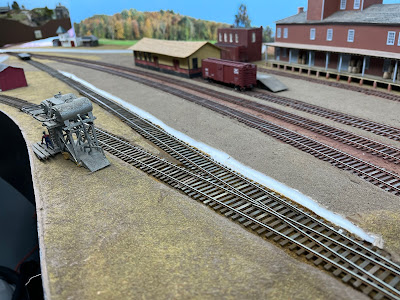Wednesday, April 26, 2023
Wednesday, April 19, 2023
Thursday, April 13, 2023
Proto 2000 S-1 Decoder Install/Test (Part 2)
As you may have noticed in my last post, I've made a bit of progress in Essex (fine-tuning some terraforming and tweaking a build template/footprint for the Dickinson's Witch Hazel distillery), and also Deep River (widening/moving the aisle to provide more room for the lace factory). But hopefully you also noticed at the end a couple of pictures of my latest decoder install. . .
This is going to be the main diesel power for the Valley Local: New Haven DEY-3 class (Alco S-1) #0967. I've been noodling on this install since at least late last year (click here for the last detailed post starting the project - "Part 1" of this conversion), trying to determine the best way to approach it and fit everything. But as of tonight, I can declare the install "DONE."
- The motor wires must be backwards since I matched the gray and orange wires to the decoder, but the loco ran backwards. Instead of reversing the (now-soldered and shrinktubed) wires, I just changed the direction in CV29.
- If I were to do this install again, I would direct-wire the gray motor wire and the two speaker wires to save 3 splices (and the associated shrink tubes, and extra wire that has to be tape tucked).
- I don't think removing the 1.5oz of weight is going to make that much of a difference to me. All of my layout is flat except for a 2% grade from East Haddam to Middletown. But even on the prototype, typical trains up the grade would only be 3-5 cars max. I'll report back.
- While JT at SSS strongly cautions against any modification of his speaker enclosures, I found that I had to file down the molding ridges on both sides to allow the body/frame to slide down onto the chassis more easily. As long as you're ONLY removing the ridge, and not thinning the wall of the enclosure, you'll be fine.
- Note that I have not (yet) installed lights. I don't know that I'll bother (the New Haven didn't use headlights during the day during my era, and the Valley Local didn't operate at night), but I left the white/yellow/blue wires intact just in case I change my mind later.
- Speaking of wires, I removed/cut off the green and violet wires (AUX 1 & AUX 2, respectively) since I didn't need them, don't expect to ever need them, and didn't want them in the way.
- The only thing I mounted into the body shell was the PowerPack:
So there you have it - lemme know what you think. And special thanks to the AML Wednesday Night Chat guys for keeping me company and for all the helpful tips and tricks. Those zoom chats are ideal for working at the bench - and with folks "joining" you for a visit!
Next step(s): Modifying and detailing the body to transform this model into as true a representation of a DEY-3 as I can. Stay tuned!




























